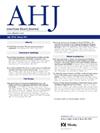Variability in Clinical Parameters as Predictors of Cardiovascular Disease in Type 2 Diabetes: A Machine Learning Approach
IF 3.5
2区 医学
Q1 CARDIAC & CARDIOVASCULAR SYSTEMS
引用次数: 0
Abstract
Background
Cardiovascular disease (CVD) remains a leading cause of morbidity and mortality in patients with type 2 diabetes mellitus (T2DM). Traditional risk prediction models often underperform in diabetic populations. This study aimed to develop and validate a machine learning (ML) model to predict CVD risk in T2DM patients using routinely collected clinical data with focus on parameter variability rather than absolute values.
Methods
We retrospectively analyzed data from the National Health and Nutrition Examination Survey (NHANES), a nationally representative public dataset, selecting 5,426 T2DM patients without prior CVD (2015-2020). Multiple ML algorithms were trained to predict 3-year CVD risk. Input variables included demographic data, comorbidities, medications, and crucially, both median values and ranges (maximum minus minimum) of clinical parameters including HbA1c, creatinine, liver enzymes, and lipid profiles. Models were validated using 5-fold cross-validation.
Results
The random forest model demonstrated superior performance with an area under the receiver operating characteristic curve of 0.81 (95% CI: 0.79–0.83). Parameter variability provided stronger predictive value than median values for key variables. The top five predictors were creatinine variability, HbA1c variability, AST variability, ALP variability, and ALT variability, highlighting the importance of metabolic stability in CVD risk reduction.
Conclusion
This study demonstrates that fluctuations in routine clinical parameters, particularly renal and glycemic markers, outperform traditional static measurements in predicting CVD risk among T2DM patients. Implementation of this ML model could enhance clinical decision-making by identifying high-risk patients who might benefit from more intensive monitoring and earlier therapeutic interventions.
作为2型糖尿病心血管疾病预测因子的临床参数变异性:机器学习方法
背景:心血管疾病(CVD)仍然是2型糖尿病(T2DM)患者发病和死亡的主要原因。传统的风险预测模型在糖尿病人群中往往表现不佳。本研究旨在开发和验证机器学习(ML)模型,利用常规收集的临床数据预测T2DM患者的心血管疾病风险,重点关注参数变异性而不是绝对值。方法回顾性分析全国健康和营养检查调查(NHANES)的数据,这是一个具有全国代表性的公共数据集,选择了5426例无CVD病史的T2DM患者(2015-2020)。训练多个ML算法来预测3年心血管疾病风险。输入变量包括人口统计数据、合并症、药物,最重要的是,包括HbA1c、肌酐、肝酶和脂质谱在内的临床参数的中位数和范围(最大值减去最小值)。采用5倍交叉验证对模型进行验证。结果随机森林模型在受试者工作特征曲线下的面积为0.81 (95% CI: 0.79 ~ 0.83),表现出较好的效果。关键变量的参数变异性比中位数具有更强的预测价值。前五大预测因子分别是肌酐变异性、HbA1c变异性、AST变异性、ALP变异性和ALT变异性,强调了代谢稳定性在降低心血管疾病风险中的重要性。结论:该研究表明,常规临床参数的波动,特别是肾脏和血糖指标,在预测T2DM患者心血管疾病风险方面优于传统的静态测量。该ML模型的实施可以通过识别高危患者来增强临床决策,这些患者可能受益于更密集的监测和早期的治疗干预。
本文章由计算机程序翻译,如有差异,请以英文原文为准。
求助全文
约1分钟内获得全文
求助全文
来源期刊

American heart journal
医学-心血管系统
CiteScore
8.20
自引率
2.10%
发文量
214
审稿时长
38 days
期刊介绍:
The American Heart Journal will consider for publication suitable articles on topics pertaining to the broad discipline of cardiovascular disease. Our goal is to provide the reader primary investigation, scholarly review, and opinion concerning the practice of cardiovascular medicine. We especially encourage submission of 3 types of reports that are not frequently seen in cardiovascular journals: negative clinical studies, reports on study designs, and studies involving the organization of medical care. The Journal does not accept individual case reports or original articles involving bench laboratory or animal research.
 求助内容:
求助内容: 应助结果提醒方式:
应助结果提醒方式:


